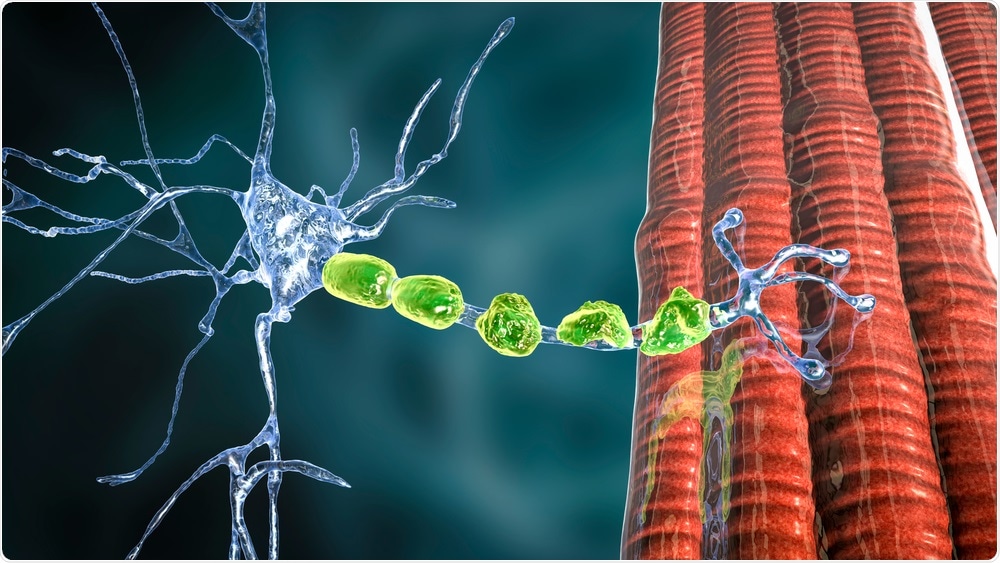.jpg) Thought LeadersProfessor Jorge RuasProfessor of Molecular PhysiologyKarolinska Institutet
Thought LeadersProfessor Jorge RuasProfessor of Molecular PhysiologyKarolinska Institutet In this interview, News-Medical speaks to Professor Jorge Ruas about his latest research into muscle physiology and how he has identified an important protein involved in motor coordination.
Please could you tell us what inspired your latest research?
The project that gave rise to this latest publication on how muscle fibers communicate with the motor neurons that innervate them, was born from our long-standing interest in understanding how changes in skeletal muscle (elicited by physical activity and exercise or by disease) affect muscle function but also the health of the entire organism.
Our projects aim to identify the precise molecular mediators of the benefits of exercise for human health not only to contribute to our understanding of human physiology but also to develop novel therapies for disease.
For us to move, smile, express ourselves, our muscles need to receive signals from specialized nerves called motor neurons. Importantly, the characteristics of communicating motor neurons and muscle fibers (called motor units) must match: fast-firing motor neurons innervate fast contraction muscle fibers (with powerful contraction), and slow firing motor neurons innervate slow contracting fibers (which are more resistant to fatigue). You need both types of motor units for power (fast) and endurance (slow).
Motor neurons and muscles are in constant communication and a signal from the motor neuron leads to muscle contraction. We wanted to know if muscles can talk back, send their own messages to motor neurons, and what are the consequences of those signals.
Understanding what signals mediate motor neuron-muscle communication is important because when this communication is disrupted (by injury, muscle disease, or motor neuron disease such as ALS – Amyotrophic lateral sclerosis), it leads to progressive muscle weakness and eventual paralysis.
Muscle health is extremely important to people's overall health. What are some of the ways people can keep their muscles healthy?
Activity, activity, activity. Incorporate as much physical activity as you can in your daily life. Walking, taking stairs instead of escalators or elevators (when possible), standing instead of sitting, and so on. The more you use your muscles, the more energy they use and the more beneficial molecules they secrete, which benefits the whole body.
Then exercise, the more structured form of activity, so you can train your muscles to become more energy-efficient and healthier. That will give you additional benefits of exercise and muscle health. These go from preventing obesity, diabetes, and cardiovascular disease to preventing certain types of cancer and even neurodegenerative diseases.

Image Credit: Rido/Shutterstock.com
For people suffering from muscle diseases, regular exercise may seem impossible. Why is it equally important that we find ways that allow everyone to receive some of the benefits of physical exercise?
That is exactly our motivation to develop these projects on identifying the molecules that mediate the beneficial effects of exercise for human health.
If we know what they are, we can try to transform them into therapeutic agents that can help patients that have limitations in performing exercise (or in exercising at the intensity that would bring that specific health benefit).
Can you describe how you carried out your latest research into muscle proteins and neuromuscular function?
In a previous study using cell culture, we had identified a muscle-secreted protein called neurturin as a factor that promoted the formation of neuromuscular junctions (the synapse between motor neurons and muscle fibers) in vitro.
We wanted to know what was the biological consequence of these effects in a live organism. We routinely use the mouse as a model organism for these proof-of-concept experiments. So we engineered a mouse that has constant and high levels of Neurturin being produced and released from the muscles.
We also analyzed human muscle biopsy data from patients with different diseases (or volunteers that performed different types of physical exercise) to understand under which conditions is neurturin released from muscles.
Finally, we used a variety of molecular techniques to understand how neurturin elicits the effects on muscle, motor neurons, and the whole organism. We also administered recombinant nerturin to wild-type mice (using viral vectors) to start evaluating the therapeutic potential of neurturin.

Image Credit: Kateryna Kon/Shutterstock.com
What did you discover?
It is well recognized that the characteristics of motor neurons have a strong impact on the characteristics of muscle fibers. For example, if you connect a slow-firing motor neuron to a fast contraction muscle fiber, that fiber will change from fast, powerful contraction to slow, fatigue-resistant.
Our study shows that changes in muscle can talk back to motor neurons and also impact their characteristics. Specifically, we found that muscle-derived Neurturin increases the number of slow muscle-motor neuron units. This is particularly important because slow motor units are more resistant to degeneration in diseases such as ALS.
It was quite surprising to find out that a molecule released from muscle fibers can actually change motor neuron identity, shifting them to a type that is associated with more resistance to degeneration, which opens really exciting possibilities for the future.
At a systemic level, Neurturin improved the overall metabolic state of the mouse and increased their motor coordination and exercise performance. This suggests Neurturin could be used to improve muscle energy metabolism, which would be advantageous in situations of diabetes, for example.
What role did genetic modification play in your research?
Without the generation of the genetically modified Neurturin transgenic mouse (the mouse model engineered to produce and release high levels of Neurturin from muscles), we would never have found these biological activities of Neurturin. This type of research, which focuses on mechanisms that depend heavily on organs “talking” to each other by releasing and sensing factors such as Neurturin, needs to be evaluated in a living organism (such as the mouse).
Indeed, when we give a medication to a patient, it will act on a preferential target organ but it will have primary and secondary effects on many other tissues and organs. We need to understand what these effects are before we move forward with the therapeutic development of neurturin.
Were there any limitations to your research? If so, what were they?
We need to make sure that our findings using cell and mouse models translate well to humans. Although these molecules and pathways are very well conserved between species, there is always the possibility that there are biological differences that change the activity of Neurturin between organisms. Now that we know what Neurturin can do, we know what to test for moving forward.
The therapeutic approach we used in the mouse relied on using modified viral vectors to deliver Neurturin into circulation. Although some of these vectors can be (and are) used in humans, using a purified form of the protein is of course easier. We are currently testing if this approach elicits the same biological effects.
How could your research help to improve the lives of patients suffering from muscle and neurological diseases such as amyotrophic lateral sclerosis (ALS)?
If the effects of Neurturin that we observed on muscle metabolism, motor neuron identity, and motor coordination translate well into humans that would be huge. Having a small protein that could be administered to patients with muscle disease, diabetes, or neuromuscular disease, to improve their health would be a game-changer.
.jpg)
Image Credit: chrupka/Shutterstock.com
Do you believe that your research could also be used to potentially develop a new drug for ALS?
We are testing that idea at the moment using Neurturin and pre-clinical models of ALS. The fact that Neurturin was able to shift motor neuron identity to a type that is known to be more resistant to neurodegeneration in ALS, makes us think that it may be useful in this disease.
What are the next steps for your research?
This project is one of several ongoing in the lab, all with the purpose of understanding why is it that exercise and muscle conditioning promote healthy longevity. In terms of Neurturin-related research, we are now moving into pre-clinical testing in neurodegenerative and metabolic diseases.
But we are testing how several other genes/molecules/pathways contribute to mediating the beneficial effects of exercise for health, and how they can be used to develop new therapies.
Where can readers find more information?
- Lab website where people can find out more about our research – www.ruaslab.science
- Press release for the Neurturin paper – https://news.ki.se/study-identifies-protein-important-for-motor-coordination-and-exercise-performance
- Open access copy of the Neurturin paper – https://www.cell.com/cell-metabolism/pdfExtended/S1550-4131(21)00422-8
About Professor Jorge Ruas
Professor of Molecular Physiology and group leader for the Molecular and Cellular Exercise Physiology research group.
Jorge Ruas received his Pharm.D. degree from the University of Lisbon, Portugal, after which he initiated pre-doctoral work at Karolinska Institutet. During his doctoral studies he investigated how cellular oxygen levels can regulate gene expression, and in 2005 received his Ph.D. in Cell and Molecular Biology..jpg)
In 2006 he moved to Boston to pursue postdoctoral studies at the Division of Metabolism and Chronic Disease at the Dana-Farber Cancer Institute and Harvard Medical School. During this period he focused on the study of transcriptional networks that control skeletal muscle physiology.
Dr. Ruas set up his laboratory at the Department of Physiology and Pharmacology at Karolinska Institutet in July 2011. In 2016 he became Associate Professor and in 2020 Professor of Molecular Physiology. His research group studies the molecular physiology of physical exercise and how to use this knowledge to develop novel therapies.
Posted in: Thought Leaders | Medical Research News | Disease/Infection News | Healthcare News
Tags: Amyotrophic Lateral Sclerosis, Biopsy, Cancer, Cardiovascular Disease, Cell, Cell Culture, Chronic, Chronic Disease, Clinical Testing, Diabetes, Exercise, Fatigue, Gene, Gene Expression, Genes, Genetic, in vitro, Laboratory, Medical School, Metabolism, Molecular Biology, Molecule, Motor Neuron Disease, Motor Neurons, Mouse Model, Muscle, Neurodegeneration, Neurodegenerative Diseases, Neuromuscular Disease, Neuron, Neurons, Obesity, Oxygen, Paralysis, pH, Pharmacology, Physical Activity, Physiology, Protein, Research, Sclerosis, Synapse, Transgenic, Walking
.png)
Written by
Emily Henderson
During her time at AZoNetwork, Emily has interviewed over 150 leading experts in all areas of science and healthcare including the World Health Organization and the United Nations. She loves being at the forefront of exciting new research and sharing science stories with thought leaders all over the world.
Source: Read Full Article
